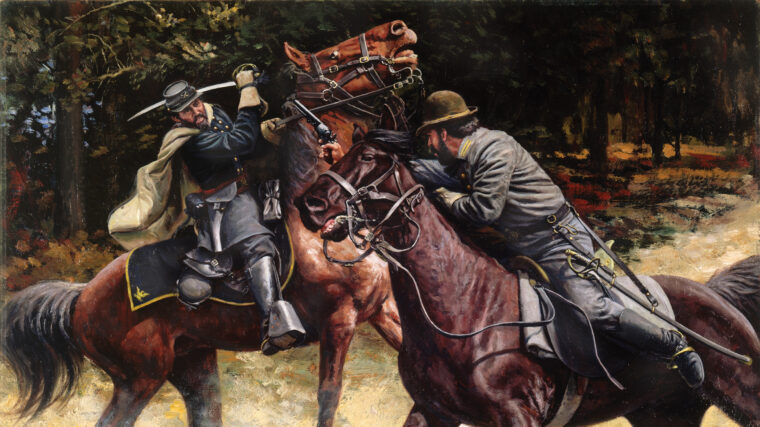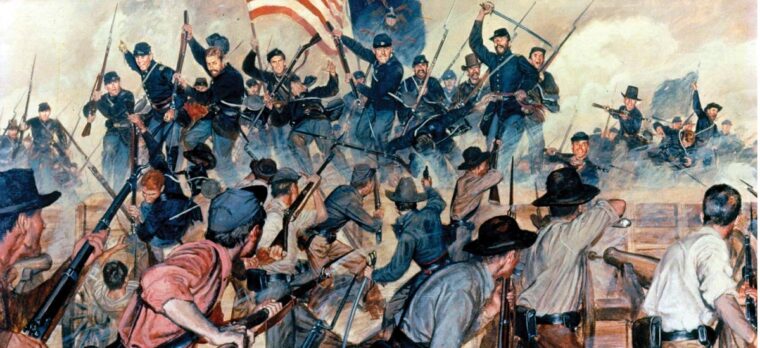
Civil War
Bloody Repulse at Bull Run
By Joshua ShepherdAfter just one month of training, the men of the 27th New York Infantry nervously sensed they would be in the middle of a real fight within minutes. Read more

Warfare History Network is your best source for military history online. This is where we bring you our coverage on all aspects of the American Civil War—from the first shots fired at Fort Sumter to Antietam to the surrender of Robert E. Lee at Appomattox. In addition to substantial military coverage, we also examine the political climate of the 1860s and how the war influenced civilian life in the North and South. A trove of Civil War photos, maps, and color illustrations complement our written contributions from a team of established writers, including William Welsh, Pedro Garcia, and acclaimed author-historian Roy Morris Jr.

Civil War
After just one month of training, the men of the 27th New York Infantry nervously sensed they would be in the middle of a real fight within minutes. Read more

Civil War
Lieutenant William B. Cushing’s Union Navy steam launch chugged up the dark Roanoke River late in 1864. Read more

Civil War
In the shadow of Cedar Mountain on the southern outskirts of Culpeper, Virginia, Major General Thomas “Stonewall” Jackson deployed the troops at the head of his column of march against a reinforced Union corps on August 9, 1862. Read more

Civil War
It is a given that troops who are successful in battle are those that have confidence in themselves and in their commanders, and this was the case with the Confederate soldiers serving under Maj. Read more

Civil War
The dense formation that constituted the Army of the Potomac’s Black Hat Brigade formed up on Joseph Poffenberger’s farm at dawn on September 17, 1862. Read more

Civil War
With freshly honed sabers, more than 2,000 Union cavalrymen rode toward the Confederate-held Rappahannock River crossing of Kelly’s Ford in March 1863 with orders to attack and rout or destroy Maj. Read more

Civil War
Union artillery shells burst in the trees at the north end of Cross Timber Hollow as Confederates in gray and butternut-colored uniforms creeped through the tangled underbrush on both sides of Telegraph Road. Read more

Civil War
George Gordon Meade did not want command of the Army of the Potomac when it was thrust upon him on the eve of the Battle of Gettysburg seven months after the Union defeat at Fredericksburg, but he had the distinction of being the division commander who had led the successful Union assault during the bloody battle in December 1862 on the south side of the Rappahannock River. Read more

Civil War
Recently detached from the Army of Tennessee, the Arkansas troops of Brig. Gen. Thomas J. Churchill’s division had not yet met their new commander when the division came under fire at Richmond, Kentucky, on August 30, 1862. Read more

Civil War
By Mike Phifer
On July 2, the day of the Battle of Gettysburg’s Peach Orchard conflict, Army of the Potomac commander Maj. Read more

Civil War
“Oh, the Lord, Henry but didn’t the Rebs get the devil sure enough,” Private Charles Grundy of the 10th Illinois Infantry Regiment wrote to a friend three days after the conclusion of the Battle of Nashville fought December 15-16, 1864. Read more

Civil War
Confederate Brig. Gen. George Maney maintained tight control of the three regiments in his first line as he pressed his attack against a key position on the extreme left flank of the Union Army on the afternoon of October 8, 1862. Read more

Civil War
The men of Brig. Gen. Alfred Iverson’s North Carolina brigade, four regiments strong, marched forward as if on parade, their rifles at the right shoulder, as they went into battle on the first day at Gettysburg. Read more
Civil War
Mr. Morris is the author of seven well-received books on 19th Century American history and literature. He has served as a consultant for A&E, the History Channel, and edited a three-book series for Purdue University Press on American Civil War and post-Civil War history, journalism and literature. Read more
Civil War
By Eric Niderost
July 3, 1863, dawned clear and bright, the warm sun promising even greater heat to come. By noon, temperatures were already in the low 90s, a typically hot and humid summer day in southern Pennsylvania. Read more

Civil War
Dripping wet Union soldiers stepped out of the North Anna River’s Jericho Ford on May 22, 1864, setting foot in Hanover County, Virginia. Read more

Civil War
At the Battle of Jonsborough, Union General William T. Sherman hoped to destroy the Army of Tennessee and seize Atlanta, Georgia. Read more

Civil War
At the start of the American Civil War in April 1861, U.S. President Abraham Lincoln proclaimed that he planned to blockade the Confederacy by stationing warships in waters off its shores. Read more

Civil War
It was raining heavily, a deluge of almost Biblical proportions that hammered down on the exhausted men of the Union’s Army of the Tennessee. Read more

Civil War
By Frank Jastrzembki
Five busts of his greatest lieutenants during the Civil War watch over the sarcophagus of Lt. Gen. Ulysses S. Read more